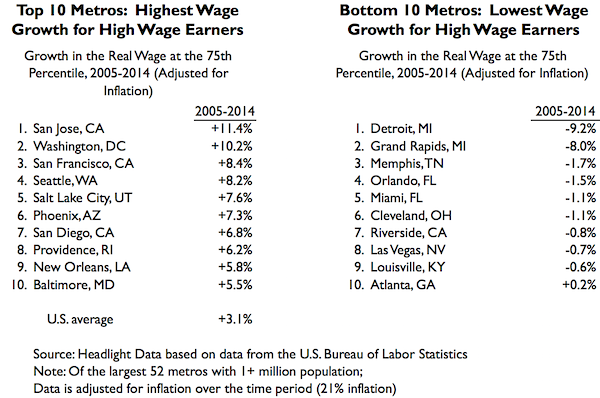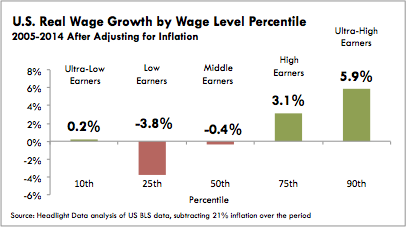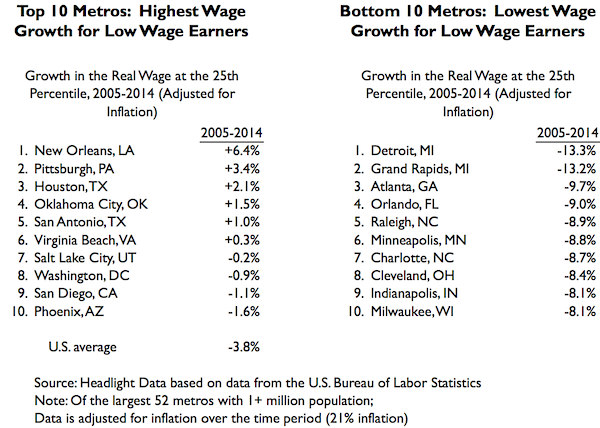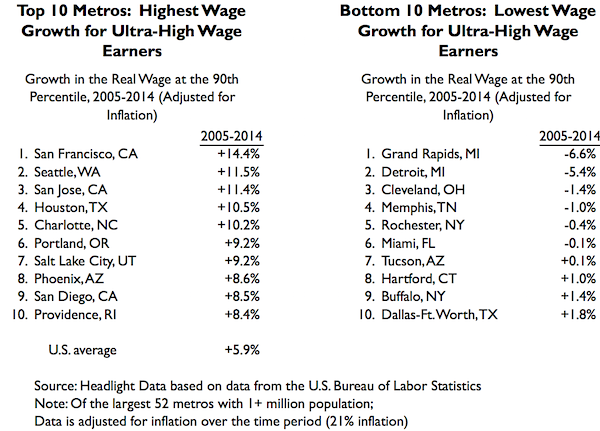U.S. Real Median Wage Shows No Increase Since 2005; Highest Wage Growth Found in New Orleans, Pittsburgh, and DC; High-Wage Earners Did Best in San Jose; Low-Wage Earners Did Best in New Orleans
The real median wage in the U.S. has not increased from 2005 to 2014, falling 0.2% after accounting for inflation. Looking at wage performance across the spectrum of wage levels, Ultra-High Wage Earners enjoyed the fastest growing wages (+5.9% at the 90th percentile) and Low-Wage Earners saw declining wages (-3.8% at the 25th percentile). Ultra-Low Wage Earners saw slightly positive wage growth (+0.2% at the 10th percentile).
Wage levels vary from $18,000 per year at the Ultra-Low Wage level (10th Percentile) to $90,000 per year at the Ultra-High Wage level (90th Percentile).
Across the 52 largest U.S. metros (with 1+ million population), the highest growth in median wages was in New Orleans (+7%), Pittsburgh (+6%) and Washington, DC (+5%). Detroit had lowest median wage growth (-14%), followed by Grand Rapids (-11%) and Atlanta (-6%).
Click here to view an interactive map of median wage growth by metro.At the High Wage level (75th percentile), the metros that generated the most wage growth were San Jose (+11%), Washington DC (+10%) and San Francisco (+8%). Detroit had the largest wage decrease (-9%), followed by Grand Rapids (-8%) and Memphis (-2%).
 Click here to view an interactive map of wage growth for Low Wage Earners.
Click here to view an interactive map of wage growth for Low Wage Earners.
At the Low Wage level (25th Percentile), only 6 of the 52 largest metros saw wages grow from 2005 to 2014. New Orleans had the highest wage growth (6%), followed by Pittsburgh (3%) and Houston (2%). Wages decreased the most in Detroit (-13%), Grand Rapids (-13%) and Atlanta (-10%).
Click here to view an interactive map of wage growth for High Wage Earners.At the Ultra-High Wage level (90th Percentile), 47 of the 52 largest metros saw wages grow from 2005 to 2014. San Francisco had the highest wage growth (14%), followed by Seattle (12%) and San Jose (11%). Wages decreased the most in Grand Rapids (-7%), Detroit (-5%) and Cleveland (-1%).
Click here to download a spreadsheet of the data.
Research, analysis and content developed by Headlight Data. Original data from the U.S. Bureau of Labor Statistics' Occupational Employment Estimates program.
About Headlight Data:
Headlight Data is an award-winning online data aggregator, designed for economic and workforce development organizations, that provides online, decision-support tools on the economy, demographics, education, workforce and public policy.





